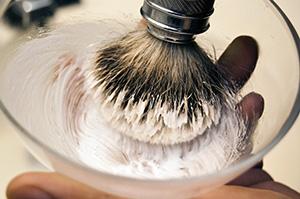
Shaving Lather: Too Dry, Too Wet, And Just Right
Lather that is mixed too dry is probably the easiest to identify. Dry lather will appear thick and sticky, lacking the characteristic creamy texture that you are trying to achieve with a shaving brush. If the brush is not loaded with enough water, the cream will break down and look and feel goopy in the bowl. It will not spread easily when you attempt to apply it to your face from the brush. Attempting to shave with this type of lather is typically very uncomfortable and is more difficult to rinse from the razor between strokes. Over the course of the shave it will only further dry down as the water quickly evaporates from your face. It is also not uncommon for the lather to start flaking off your face as you shave. These indicators are pretty easy to see when looking at lather that is too dry. In addition, your face will feel rough and sore from the lack of protective lubricating and moisturizing properties that your shaving cream or soap should provide.
Too Dry


Lather that is too wet can sometimes be a bit more difficult to identify, especially for new shavers. Overly wet lather can sometimes fool a shaver because it generally is produced in a large amount, looks creamy, and loads into the shaving brush at the beginning of the shave. It can even be comfortable and feel well lubricated on your first pass when the stubble is at its longest length; however, it can cause problems as the blade gets closer to the skin in subsequent passes. Lather that has too much water can be noticed when you set the brush down on its base between passes and see the loft collapse and run down towards the brush handle. In addition, you can usually spot larger bubbles and signs of runniness in a wet lather, especially when you are applying the lather to your face. It can create problems during your cutting passes because its thinner texture will run down your face, which can be especially problematic for straight shavers or those still learning the double-edge as they tend to take their time and cut at a slower pace. This will lead to irritation and soreness due to lack of protection because the soap or cream is not dense enough to track the blade properly.
Too Wet


The ideal lather is a delicate balance between the two extremes of too dry and too wet. For many shavers, the easiest method is to use the Load/Hydrate Technique where you start with the lather dry and slowly add water a little at a time by dipping the ends of the brush into warm water and building the lather until the right consistency is met. Once the correct cream/soap to water ratio has been achieved, the lather will appear rich and creamy in texture with little to no visible air bubbles. This may look more like the thick foam that dispenses out of canned shaving creams; however, a quality traditional cream lathered with a brush will always perform much better than the canned version. Properly hydrated lather loads into the brush easily and spreads across the face smoothly and evenly. It also stays in place long enough for cutting passes to be completed without flaking off or sliding down your neck like improper lather will often do. When you set the brush down between passes, good lather maintains its consistency in the loft and provides consistent protection when reapplied between passes.
Perfect Lather


These three stages are a high-level overview of shaving lather. Every product has a unique formulation and every brush will require a different amount of water based on its size, density, and grade of hair. Environmental factors, such humidity in your area and the hardness of the water in your home, can also affect how your lather builds. Despite these variables, the perfect lather should always be free of excess bubbles and should have a smooth and creamy consistency as well as maintain its texture throughout the 10 to 15 minutes it takes most people to complete a traditional shave.
RELATED ARTICLES...
Tutorial: Creating Lather with the Load/Hydrate Technique
Pick Your Poison: Soap or Cream?
Ode to a Shaving Brush

Leave a comment